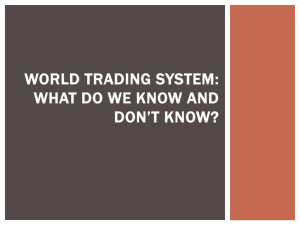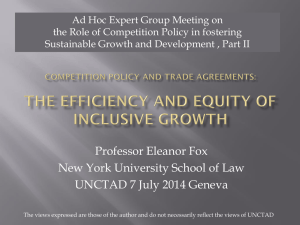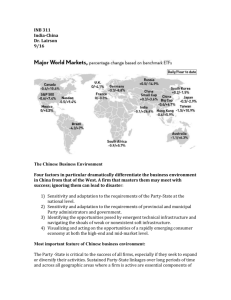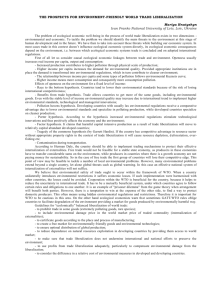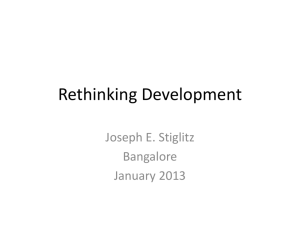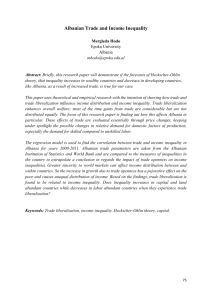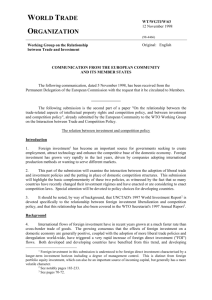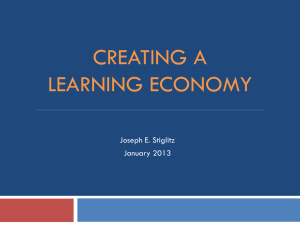View/Open
advertisement
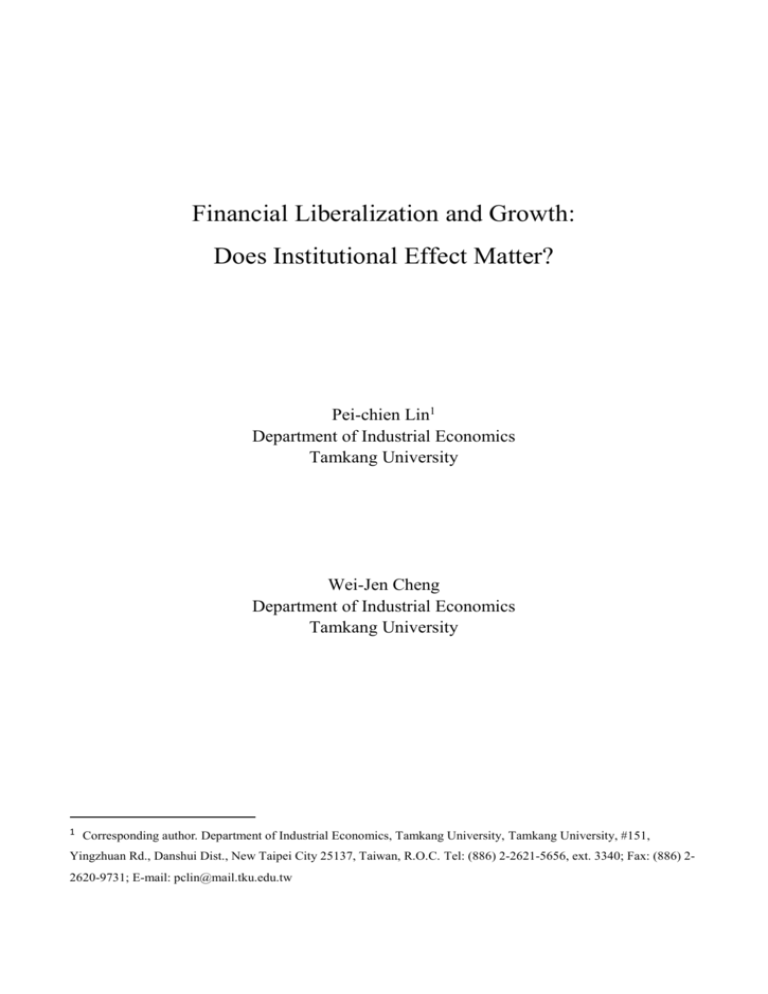
Financial Liberalization and Growth: Does Institutional Effect Matter? Pei-chien Lin1 Department of Industrial Economics Tamkang University Wei-Jen Cheng Department of Industrial Economics Tamkang University 1 Corresponding author. Department of Industrial Economics, Tamkang University, Tamkang University, #151, Yingzhuan Rd., Danshui Dist., New Taipei City 25137, Taiwan, R.O.C. Tel: (886) 2-2621-5656, ext. 3340; Fax: (886) 22620-9731; E-mail: pclin@mail.tku.edu.tw Abstract The positive growth effect of financial liberalization in the form of equity market openness or capital account openness has been well documented in the literature. In this paper, I will go further to investigate if the growth effect may be heterogeneous across countries at different stages of institutional development, such as the degrees of corruption, bureaucracy, and law and order. The results obtained suggest that after controlling for other determinants of growth, the positive growth effect of equity market openness disappeared after considering institutional effect. However, when considering the interaction between equity market openness and institutional factor, the result shows that an open equity market positively affects growth only after a country has achieved a certain degree of institutional development, and this institutional effect is especially important for less developed countries. This provides support to the view that there is an optimal sequencing for equity market liberalization. Keywords: Equity market liberalization; Financial liberalization; Capital account openness; Quality of institutions; growth JEL Classification: F36; F43; G15; G18 1. Introduction The remainder of this article is structured as follows. Section 2 briefly outlines the empirical strategy applied. Section 3 describes the data sources and the construction of relevant variables. Section 4 presents our main results. Section 5 provides some sensitivity analysis. Lastly, Section 6 concludes. 2. Empirical Strategy For our research purpose, we consider the following regression equation: g i,t ln yt ln yt 1 i t ln yt 1 LIBi,t X i',t 1 vi,t (1) The dependent variable is the logarithmic growth rate ( g i ,t ) of annual real per capita GDP ( y i ,t ) in country i at period t and the logarithmic lag income level ( ln y i ,t 1 ) is the corresponding initial income level to test for the hypothesis of convergence. i and t respectively represent the country fixed effects and year fixed effects that control for time-invariant country characteristics and global trends. The variable LIB i ,t , which is our main interest, is an dummy variable that takes the value one in the year when the capital market is open for foreigners and in the following years. The vector X i',t 1 includes time-varying covariates, such as investment, government spending, inflation etc. (Emphasized the consideration of institutional factor) Equation (1) constitutes a difference-indifference model, in which countries that open their capital market to foreigners are the ‘treated’ group, while non-reforming countries, i.e., those countries that always open or always close their capital market, serve as the ‘control’ group. As the model includes the country and the year fixed-effects, the coefficient measures the annual growth effect of capital market opening in reforming countries compared to the general growth patterns in non-reforming countries. As difference-in-difference estimators may exacerbate the downward bias in the standard errors arising from positive residual autocorrelation in the static models, we follow the proposal of Bertrand et al. (2004) and adjust standard errors based on generalized White-like formula by allowing for country-level clustered heteroscadesticity and autocorrelation. In addition, for later robustness check, we will further estimate dynamic panel versions of (1) to control for growth persistence and income level difference. 3. Data In this section, we will briefly describe the construction of the relevant variables and their original sources. First, we start with the most important variable in this paper -the indicator of financial liberalization. This variable corresponds to a date of formal regulatory change after which foreign investors officially have the opportunity to invest in domestic equity market and is based on Bekaert and Harvey’s (2002) “A Chronology of Important Financial, Economic and Political Events in Emerging Markets.” With this dating information, we construct an indicator variable that takes the value of one when foreign investor can own the equity of a particular market and otherwise zero. Furthermore, for later robustness analyses, we employ an alternative measure of financial liberalization: First sign. This indicator is based on the earliest of three possibilities: a launching of country fund, an American Depositary Receipt (ADR) announcement, and an official liberalization. Again we establish a dummy variable corresponding to the earliest date of these three events. Our dependent variable is the growth rate of real GDP per capita, which is defined as the annual logarithmic change of real per capita GDP. To account for testing the hypothesis of convergence, we also consider initial income level, which is defined as the lagged (natural logarithm of) real per capita GDP. Other controls include the following variables: investment, defined as the ratio of gross capital formation to annual GDP, government consumption, measured by general government consumption as a share of GDP, schooling, measured as average years of schooling in the population aged 25 and above; inflation, measured as log of one plus inflation rate, open to trade, measured by log of imports plus exports as a ratio of GDP. The original data to construct these variables are mostly taken from the World Development Indicators of World Bank, except the schooling variable, which is from Barro and Lee (2001).2 For our research purpose, we also consider the quality of institutions, which is the sum of the International Country Risk Guide (ICRG) Political Risk subcomponents: corruption, bureaucracy, and law and order. Specifically, the variable of corruption is an averaged ranking measure of corruption within the political system, with a high rating (6.0) indicating low degree of corruption and a low rating (1.0) indicating high potential corruption. The variable of bureaucracy is a rating system of institutional strength and quality of the bureaucracy. The range of the rating is between one to four points and high points are given to countries where the bureaucracy has the strength and expertise to govern without drastic changes in policy or interruptions in government services. The variable of law and order assess Law and Order separately, with each subcomponent comprising zero to three points. Overall, a country can enjoy a high rating (6.0) in terms of its judicial system, but a low rating (1.0) if the law is ignored for a political aim. 2 The original data of schooling correspond by construction to five-year averages. A simple linear interpolation was used to convert them in annual basis. Ultimately, our full sample contains 88 countries, in which 21 countries are grouped as developed economies and 67 countries are defined as developing economies.3 Details about the sample countries and their corresponding date of financial liberalization please refer to Appendix. 4. Results 4.1 Results for the full sample case For comparison purpose, we first assess the unconditional effect of financial liberalization on growth by estimating regression (1) with time effect, fixed effect and both fixed and time effects (differencein-difference model) to all countries included in our sample (the full sample). Essentially, the regression identifies the annual per capita GDP growth post- versus pre- liberalization, respectively or simultaneously controlling for country-specific time in-variant growth conditions and global business cycle effects. Furthermore, we also include initial income (lagged level of per capita GDP) in line with the exogenous growth theory to test the ‘catch up’ effect and the estimate results are reported in columns (1) – (3) in Table 1. In column (1) we control for global shocks adding time fixed-effects ( t ). The coefficient on the financial liberalization indicator is 0.012 and statistically significant at the 1% level, indicating that countries which liberalize their capital market will possess 1.2% higher growth rate than those non-liberalizing countries. However, the coefficient on initial income is positive and not statistically at any significance level, thus providing no evidence of convergence in per capita GDP. In column (2) we isolate the within effect of financial liberalization by adding a vector of country dummies ( i ). It can be seen that as we consider the variation within countries, the estimate coefficient on financial liberalization is twice lager than the estimate from time fixed-effect model and also statistically significant at the 1% level. Furthermore, the estimated coefficient on initial income is negative and statistically significant at the 1% level, lending strong support for the ‘catch up’ effect. The difference-in-difference coefficient in model (3) where we control for both country and year fixedeffects implies an average growth effect of financial liberalization of approximately 1.1%. The coefficient is statistically different from zero at the 1% significance level. As the empirical literature has considered numerous variables to explain cross-country growth difference, in column (4) of Table 1 we report the results of the conditional difference-in-difference models that control for standard growth covariates. By so doing, we can explore whether the significant effect of financial liberalization documented in the unconditional models still retained when other growth covariates such as capital accumulation (investment), sound government (government consumption), human capital accumulation (schooling), effectiveness of monetary policy (inflation ) and trade policy (openness to trade) are simultaneously considered. It can be seen that even with these standard growth covariate jointly controlled, the coefficient on financial 3 We take those countries which joined The Organization for Economic Co-operation and Development (OECD) before 1980 as developed economies, and the rest of the countries in the sample are grouped as developing economies liberalization retains significance at the 5% level, implying a short-run annual growth effect of 0.9%. In addition, the model in column (4) of Table 1 shows that openness to trade enters with a significant positive estimate, while both government consumption and inflation enter with a significantly negative coefficient. On the other hand, the coefficient on human capital proxy (schooling) is insignificant. Although this is not supportive of growth models stressing human capital, it is in line with panel studies revealing weak within correlations between schooling and growth (Kruger and Lindahl, 2001). 4.2 Results for the subsamples We then proceed to divide the full sample into the developed and the developing subgroups. Generally, we classify those countries joined the Organization for Economic Co-operation and Development (OECD) before 1980 as developed economies, and the rest of the countries in the sample are grouped as developing economies. With these two subsamples, we rerun the unconditional and conditional difference-in-difference models to see whether financial liberalization will exert heterogeneous growth effect in alternative groups of countries which are in different stages of development. The estimate results are reported in Table 2. Columns (1) and (2) of Table 2 present the results for the developed subgroup. It can be seen that for developed countries though ‘catch up’ effect significantly exists in both unconditional and conditional models, the growth effect of financial liberalization is trivial and statistically insignificant, implying that the policy of financial liberalization may not be an effective impetus to short-run growth in developed countries. In addition, the regression results from the conditional model also show that openness to trade of a country is the most important factor that affects a country’s short run growth, while other determinants of growth show no such significant growth effect in developed countries. Next we focus on the results reported in columns (3) and (4) for the group of developing countries. As can be seen that the impact of financial liberalization on economic growth is positive, respectively 0.013 and 0.010 in the unconditional and conditional cases, and statistically significant at the conventional levels, thus indicating that the adoption of financial liberalization in the developing subgroup may be an effective measure to stimulate short-run growth. In general, the estimate result from the conditional model shows that the implementation of financial liberalization policy will approximately exert an average growth of 1.1% for developing countries. By the way, in the conditional model, we can see that while government consumption and inflation have negative impact on growth, openness to trade exerts a positive growth effect. By combining the above findings, it seems reasonable to conjecture that the growth effect of financial liberalization in the whole sample is mainly driven by the outcome of developing countries. 4.3 Result of adding institutional factors for developing countries As it can be seen from the previous section that financial liberalization seems to be effective in developing countries but not in developed countries, in this section we continue to examine whether the finding of positive growth effect from financial liberalization adopted in developing countries will alter if additional institutional factors are considered. The notion of institutions typically refers to a wide range of structure that affect economic outcomes, such as contract enforcement, property rights, investor protection, and the political system and the like. Empirical evidence, such as La Porta et al. (1997, 1998) and Acemoglu et al. (2001, 2002), generally suggests that institutions matter for economic performance and developed countries have much better institutions than developing ones. Accordingly, we follow Bekaert et al. (2005) to particularly consider a quality of institutions measure using three sub-components of the ICRG political risk rating: the institutional effect in the respects of the degree of political transparency (corruption), the strength and quality of the bureaucracy (bureaucracy) and the soundness of the law and order system (law and order). Furthermore, individual growth effects of these three components are also additionally investigated. We first estimate the models with these institutional factors added to the original specification in an independent manner and the results are presented in Table 3. As shown in column (1) of Table 3, we find that the growth effect of financial liberalization enhanced slightly from 0.011 to 0.013, when a comprehensive measure of institutions added to the model. In addition, the indicator of institutional quality itself also add additional 2% to economic growth, thus providing preliminary evidence that institutional quality does matters for enhancing the growth effect of financial liberalization in developing countries. We then proceed to investigate the individual growth effect of these three subcomponents. In columns (2) and (3) of Table 3, we find that when the indicator of the degree of political transparency (corruption) and the strength and quality of the bureaucracy (bureaucracy) are separately added to the model, the growth effect of financial liberalization is improved from 0.011 to 0.012, albeit corruption and bureaucracy themselves do not exert any significant effect on growth. On the other hand, when add the measure of the law and order system to the model, we find that the growth effect of financial liberalization disappeared while the system of law and order itself possesses a statistically significant positive effect on growth. (Why so?) Alternatively, we consider including an interaction term of financial liberalization and institutional factors to the benchmark model presented in column (4) of Table 2. By modeling the role of institutional quality in the effectiveness of financial liberalization in this manner, we can discern the heterogeneous growth effects of financial liberalization across countries depending on the institutional quality of each country. As it can be seen from Table 4, when this interaction term is added to the benchmark model, the growth effects directly from financial liberalization in all models are statistically insignificant. Rather, the coefficient on the interaction term of financial liberalization and institutions is 0.004, which is statistically significant at the 5% level. This outcome implies that countries with higher institutional quality will have higher growth rate resulting from the adoption of financial liberalization policy. For instance, When look at the interaction terms of the three subcomponents respectively with financial liberalization reported in columns (2)-(4) in Table 4, we find that only the indicator of law and order is statistically matter to determine the effectiveness of financial liberalization on growth. It is widely accepted in the literature that the soundness of the law and order system is relevant to contract enforcement, property rights, and investor protection, which are important to foreign investors’ decision to invest in the domestic markets, and hence the influence of financial liberalization on domestic economic performance may be contingent on the soundness of the law and order system. As such, we can conclude that the quality of institutions, especially the soundness of law and order system, does matter for the effectiveness of financial liberalization on economic growth. In other words, the countries with higher quality of institutions, especially the judicial system, will possess higher growth rate from adopting financial liberalization policy. 5. Robustness Checks In this section, we perform a battery of experiments to check the robustness of our main finding, i.e., the quality of institutions, especially the law and order system, does matter for the effectiveness of financial liberalization on improving economic performance. First of all, to check for the sensitivity of our main results to alternative indicator of financial liberalization, we re-estimate the of Equation (1), using 6. Conclusion AAA Reference Table 1 Estimated Growth Effect of Financial Liberalization (Full Sample) Difference in Difference VARIABLES official liberalization initial income Time FE (1) Country FE (2) Unconditional (3) Conditional (4) 0.012*** (0.003) 0.001 (0.001) 0.024*** (0.003) -0.058*** (0.009) 0.011*** (0.004) -0.078*** (0.009) 0.009** (0.004) -0.076*** (0.012) investment -0.040 (0.041) -0.117** (0.050) -0.000 (0.003) -0.012* (0.007) 0.050*** (0.012) government consumption schooling inflation openness to trade Constant Observations R-squared Number of countries -0.002 (0.008) 2,199 0.062 88 0.452*** (0.068) 2,199 0.151 88 0.602*** (0.071) 2,199 0.203 88 Robust standard errors in parentheses *** p<0.01, ** p<0.05, * p<0.1 0.595*** (0.084) 1,843 0.237 79 Table 2 Estimated Growth Effect of Financial Liberalization (Subsamples) Difference in Difference Estimates Developed Countries VARIABLES official liberalization initial income (1) (2) (3) (4) 0.005 (0.006) -0.089*** (0.023) 0.006 (0.005) -0.063* (0.031) 0.013** (0.005) -0.080*** (0.011) 0.010* (0.005) -0.078*** (0.013) investment -0.092 (0.079) -0.004 (0.098) -0.000 (0.002) -0.046* (0.027) 0.117*** (0.024) government consumption schooling inflation openness to trade Constant Observations R-squared Number of countries Developing Countries 0.857*** (0.223) 524 0.301 21 0.586** (0.272) 501 0.384 21 Robust standard errors in parentheses *** p<0.01, ** p<0.05, * p<0.1 -0.026 (0.046) -0.121** (0.055) 0.000 (0.005) -0.013* (0.007) 0.044*** (0.012) 0.570*** (0.076) 1,675 0.203 67 0.554*** (0.087) 1,342 0.235 58 Table 3 Adding Independent Institutional Effects (Developing countries) Difference in Difference Estimates VARIABLES official liberalization initial income investment government consumption schooling inflation openness to trade institution (1) (2) (3) (4) 0.013** (0.006) -0.103*** (0.013) -0.072 0.012** (0.006) -0.100*** (0.014) -0.066 0.012** (0.006) -0.099*** (0.014) -0.060 0.008 (0.005) -0.113*** (0.013) -0.088 (0.055) -0.137** (0.066) 0.003 (0.006) -0.014** (0.006) 0.053*** (0.011) 0.002** (0.056) -0.146* (0.081) 0.002 (0.006) -0.014** (0.007) 0.051*** (0.012) (0.055) -0.150* (0.081) 0.002 (0.006) -0.014** (0.007) 0.049*** (0.011) (0.053) -0.106 (0.078) 0.003 (0.005) -0.015** (0.006) 0.054*** (0.012) (0.001) corruption 0.003 (0.003) bureaucracy 0.002 (0.003) law and order Constant 0.738*** 0.731*** 0.728*** 0.006*** (0.002) 0.806*** Observations R-squared Number of countries (0.093) (0.100) (0.099) (0.091) 972 0.285 51 966 0.281 51 967 0.280 51 946 0.292 50 Robust standard errors in parentheses *** p<0.01, ** p<0.05, * p<0.1 Table 4 Adding Interactive Institutional Effects (Developing countries) Difference in Difference Estimates VARIABLES official liberalization initial income investment government consumption schooling inflation openness to trade official liberalization institution official liberalization corruption official liberalization bureaucracy official liberalization law and order (1) (2) (3) (4) -0.019 (0.018) -0.101*** (0.013) -0.010 (0.018) -0.096*** (0.015) 0.006 (0.012) -0.098*** (0.014) -0.007 (0.011) -0.109*** (0.013) -0.077 (0.052) -0.146** (0.066) 0.002 (0.006) -0.015** (0.006) 0.055*** (0.012) -0.076 (0.054) -0.145* (0.082) 0.001 (0.006) -0.014** (0.006) 0.053*** (0.012) -0.060 (0.054) -0.149* (0.081) 0.002 (0.006) -0.014** (0.007) 0.051*** (0.011) -0.079 (0.054) -0.122 (0.079) 0.003 (0.006) -0.015** (0.007) 0.053*** (0.011) 0.004* (0.002) 0.008 (0.005) 0.003 (0.005) 0.005* (0.003) Constant Observations R-squared Number of countries 0.746*** 0.720*** 0.725*** 0.793*** (0.093) 972 0.287 51 (0.103) 966 0.286 51 (0.097) 967 0.280 51 (0.094) 946 0.286 50 Robust standard errors in parentheses *** p<0.01, ** p<0.05, * p<0.1 Table 5 Alternative Indicator of Financial Liberalization (Independent Institutional Effect) Difference in Difference Estimates VARIABLES official liberalization initial income investment government consumption schooling inflation openness to trade institution corruption bureaucracy law and order (1) (2) (3) (4) 0.010* (0.006) -0.099*** 0.009 (0.006) -0.096*** 0.009 (0.006) -0.095*** 0.006 (0.005) -0.110*** (0.014) -0.068 (0.055) -0.133** (0.066) 0.003 (0.006) -0.014** (0.006) 0.052*** (0.014) -0.062 (0.056) -0.142* (0.081) 0.002 (0.006) -0.014** (0.007) 0.051*** (0.015) -0.056 (0.055) -0.146* (0.081) 0.002 (0.006) -0.014* (0.007) 0.049*** (0.013) -0.086 (0.053) -0.102 (0.078) 0.003 (0.006) -0.015** (0.006) 0.054*** (0.012) 0.002** (0.001) (0.012) (0.012) (0.012) 0.003 (0.003) 0.002 (0.003) 0.006*** (0.002) Constant Observations R-squared Number of countries 0.709*** (0.096) 972 0.282 51 0.707*** (0.098) 966 0.279 51 0.699*** (0.100) 967 0.277 51 0.791*** (0.089) 946 0.290 50 Robust standard errors in parentheses *** p<0.01, ** p<0.05, * p<0.1 Table 6 Alternative Indicator of Financial Liberalization (Interactive Institutional Effect) Difference in Difference Estimates VARIABLES official liberalization initial income investment government consumption schooling inflation openness to trade official liberalization institution official liberalization corruption official liberalization bureaucracy official liberalization (1) (2) (3) (4) -0.018 (0.017) -0.096*** -0.007 (0.017) -0.092*** 0.008 (0.011) -0.093*** -0.009 (0.011) -0.106*** (0.013) -0.072 (0.052) -0.147** (0.065) 0.002 (0.006) -0.014** (0.006) 0.054*** (0.015) -0.067 (0.054) -0.145* (0.081) 0.001 (0.006) -0.014** (0.006) 0.051*** (0.014) -0.054 (0.054) -0.144* (0.081) 0.002 (0.006) -0.014* (0.007) 0.050*** (0.013) -0.078 (0.053) -0.120 (0.078) 0.003 (0.006) -0.015** (0.007) 0.053*** (0.011) 0.004* (0.002) (0.012) (0.012) (0.011) 0.006 (0.005) 0.001 (0.004) 0.005* law and order (0.003) Constant Observations R-squared Number of countries 0.714*** (0.0907) 972 0.284 51 0.693*** (0.102) 966 0.281 51 0.690*** (0.096) 967 0.277 51 0.777*** (0.091) 946 0.285 50 Robust standard errors in parentheses *** p<0.01, ** p<0.05, * p<0.1 Table 7 Dynamic Model (Independent Institutional Effect) Difference in Difference Estimates VARIABLES official liberalization L(1).growth L(2).growth initial income investment government consumption schooling inflation openness to trade institution corruption bureaucracy (1) (2) (3) (4) 0.013** (0.005) 0.139** (0.058) 0.077* 0.012** (0.005) 0.158*** (0.055) 0.080* 0.013** (0.005) 0.158*** (0.056) 0.078* 0.009* (0.005) 0.141** (0.055) 0.068 (0.046) -0.108*** (0.015) -0.108** (0.050) -0.083 (0.060) 0.003 (0.005) -0.008 (0.047) -0.106*** (0.015) -0.104** (0.050) -0.062 (0.072) 0.001 (0.005) -0.008 (0.047) -0.105*** (0.016) -0.098* (0.050) -0.067 (0.071) 0.001 (0.005) -0.007 (0.047) -0.118*** (0.014) -0.118** (0.050) -0.040 (0.071) 0.002 (0.005) -0.009 (0.005) 0.053*** (0.011) 0.002** (0.001) (0.005) 0.051*** (0.011) (0.006) 0.0490*** (0.011) (0.005) 0.054*** (0.012) 0.00289 (0.00265) 0.002 (0.002) law and order Constant Observations R-squared Number of countries 0.772*** (0.106) 972 0.305 51 0.775*** (0.105) 966 0.306 51 0.769*** (0.111) 967 0.304 51 0.006*** (0.002) 0.843*** (0.098) 946 0.310 50 Robust standard errors in parentheses *** p<0.01, ** p<0.05, * p<0.1 Table 8 Dynamic Model (Interactive Institutional Effect) Difference in Difference Estimates VARIABLES official liberalization L(1).growth L(2).growth initial income investment government consumption schooling inflation openness to trade official liberalization institution official liberalization corruption (1) (2) (3) (4) -0.019 (0.017) 0.140** (0.058) -0.008 (0.018) 0.154*** (0.055) 0.006 (0.011) 0.157*** (0.056) -0.007 (0.010) 0.146** (0.055) 0.074 (0.046) -0.105*** (0.014) -0.111** (0.047) -0.092 (0.061) 0.002 (0.005) 0.079* (0.047) -0.102*** (0.015) -0.111** (0.048) -0.064 (0.072) 0.000 (0.005) 0.077 (0.047) -0.104*** (0.015) -0.097* (0.049) -0.066 (0.072) 0.001 (0.005) 0.071 (0.047) -0.115*** (0.014) -0.112** (0.050) -0.052 (0.073) 0.002 (0.005) -0.009 (0.006) 0.055*** (0.011) 0.004** (0.002) -0.008 (0.005) 0.053*** (0.011) -0.008 (0.006) 0.050*** (0.011) -0.009 (0.006) 0.054*** (0.011) 0.007 (0.005) official liberalization 0.003 bureaucracy official liberalization law and order Constant (0.004) Observations R-squared Number of countries 0.780*** (0.106) 972 0.308 51 0.764*** (0.108) 966 0.309 51 0.764*** (0.107) 967 0.303 51 Robust standard errors in parentheses *** p<0.01, ** p<0.05, * p<0.1 Appendix: Countries Liberalization indicator First sign Australia * * Austria * * Canada * * Denmark * * Finland * * France * * Germany 1995 1995 Greece 1987 1987 Iceland 1991 1991 Ireland * * Japan 1983 * Netherland * * New Zealand 1987 1987 Norway - - Panel A: Developed Countries 0.005** (0.003) 0.838*** (0.101) 946 0.306 50 Portugal 1986 1986 Spain 1985 1985 Sweden * * Switzerland * * Turkey 1989 1989 United Kingdom * * United States * * Algeria - - Argentina 1989 1989 Bangladesh 1991 1991 Barbados * * Benin - - Burkina Faso - - Brazil 1991 1991 Central African Republic - - Chile 1992 1989 Chad - - Cote d'Ivoire 1995 1995 Cameroon - - Congo - - Colombia 1991 1991 Costa Rica - - Dominican Republic - - Ecuador 1994 1994 Panel B: Developing Countries Egypt 1992 1992 El Salvador - - Fiji - - Gabon - - Ghana 1993 1993 Gambia - - Guatemala - - Guyana - - Honduras - - Indonesia 1989 1989 India 1992 1986 Iran - - Israel 1993 1987 Jamaica 1991 1991 Jordan 1995 1995 Kenya 1995 1995 Korea 1992 1984 Morocco 1988 1988 Madagascar - - Mexico 1989 1989 Mali - - Malta 1992 1992 Mauritius 1994 1994 Malawi - - Malaysia 1988 1988 Niger - - Nigeria 1995 1995 Nicaragua - - Nepal - - Oman 1999 1999 Pakistan 1991 1991 Peru 1992 1992 Philippines 1991 1987 Paraguay - - Rwanda - - Saudi Arabia 1999 1997 Senegal - - Singapore 1900 1900 Sierra Leone - - Sri Lanka 1991 1991 Syria - - South Africa 1996 1994 Togo - - Thailand 1987 1985 Trinidad and Tobago 1997 1997 Tunisia 1995 1995 Uruguay - - Venezuela 1990 1990 Zambia - - Zimbabwe 1993 1993
